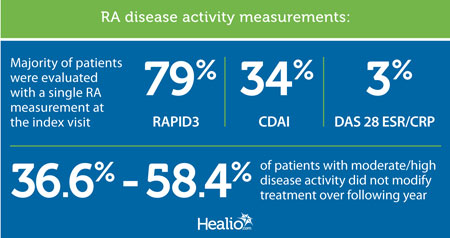Half of Patients With RA Do Not Modify Therapies to Meet Treat-to-target Guidelines

CHICAGO — Among patients with rheumatoid arthritis with moderate/high disease activity, one-third to two-thirds failed to change therapies over the following year to attain low disease activity as recommended by the American College of Rheumatology and EULAR, according to data presented here.
“Are rheumatologists practicing what they preach in striving to attain low disease activity or remission?” Jeffrey R. Curtis, MD, MS, MPH, of the University of Alabama at Birmingham, and a member of the Healio Rheumatology peer perspective board, said during a press conference. “We have national and international guidelines that suggest that we should be getting our arthritis patients into remission or as close to that as possible — but is this actually happening in the real world?”
To determine the extent to which patients with RA adjusted their therapies in accordance with treat-to-target guidelines to attain remission or low-disease activity, Curtis and colleagues extracted data from the ACR’s RISE registry to identify adult patients with RA (n=50,996) who had at least one rheumatologist visit with a disease activity measure available, such as RAPID3 or CDAI, in 2016.

The researchers evaluated disease activity measurements used for each patient and calculated the proportion of patients who exhibited moderate/high disease activity at the index visit. Curtis and colleagues then compared the treatment and disease activity of patients at baseline with follow-up visits in the following 7 to 12 months. They also conducted subgroup analyses for patients with “persistent” moderate/high disease activity, those with prior biologic use, those with seropositive RA, as well as those with past methotrexate use.
Curtis and colleagues observed that the majority of patients were evaluated with a single RA measurement at the index visit, with RAPID3 used most commonly (79%), followed by CDAI (34%) and DAS 28 ESR/CRP (3%).
According to study results, 36.6% to 58.4% of patients with moderate/high disease activity did not modify their treatment over the following year. Moreover, the researchers found that those on combination therapy with methotrexate and a biologic were the least likely to switch therapies.
“Over the next year, between one-third and two-thirds of individuals did not have any of their treatments switched; they didn’t add a biologic or targeted therapy and they didn’t change to a new one,” Curtis said. “Although few things in medicine are 100%, guidelines would suggest that most of those people should actually have their treatments switched.”

Curtis noted that the patients’ background treatment was indicative of whether that patient was likely to change therapies. Patients who were not receiving a biologic or a targeted therapy were significantly more likely to change therapies than patients already receiving combination therapy such as methotrexate and a biologic.
Additionally, the researchers determined that when RAPID3 and CDAI measurements were consistent, patients were approximately twice as likely to change therapies compared with when these measurements were in conflict— such as, moderate/high by RAPID3 and low/remission by CDAI.
“As a field, we need to better practice what we preach,” Curtis said. “If we really mean that we should be striving to get patients into remission or low disease activity, it’s not happening between one- and two-thirds of the time.”
He added, “We also definitely need more interventions where patients are encouraged to switch their therapies to want to do better. I think we need to empower patients to be their own advocates, to take charge of their health, to have patients come in and ask their doctor ‘Am I in remission?’ ‘How do you know?’ ‘How do we measure that?’ I’m still waiting for the day that patients will come to us, initiating the conversation about whether they should be switching therapies, as this study so clearly indicates is needed much of the time.” —Robert Stott
Disclosures: Curtis reports consulting relationships with Amgen and Radius. Please see the study for all other authors’ relevant financial disclosures.
Reference:
Yun H et al. Abstract 2856. Presented at ACR/ARHP Annual Meeting; Oct. 20-24, 2018; Chicago.

